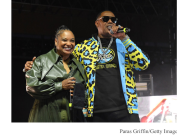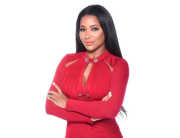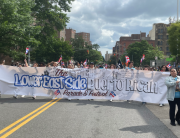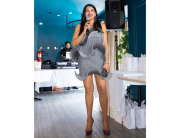Knitted fabric is a textile that results from knitting, the process of inter-looping of yarns or inter-meshing of loops. Its properties are distinct from woven fabric in that it is more flexible and can be more readily constructed into smaller pieces, making it ideal for socks and hats.
In weaving, threads are always straight, running parallel either lengthwise (warp threads) or crosswise (weft threads). By contrast, the yarn in knitted fabrics follows a meandering path (a course), forming symmetric loops (also called bights) symmetrically above and below the mean path of the yarn. These meandering loops can be easily stretched in different directions giving knit fabrics much more elasticity than woven fabrics. Depending on the yarn and knitting pattern, knitted garments can stretch as much as 500%.
For this reason, knitting is believed to have been developed for garments that must be elastic or stretch in response to the wearer’s motions, such as socks and hosiery. For comparison, woven garments stretch mainly along one or other of a related pair of directions that lie roughly diagonally between the warp and the weft, while contracting in the other direction of the pair (stretching and contracting with the bias), and are not very elastic, unless they are woven from stretchable material such as spandex. Knitted garments are often more form-fitting than woven garments, since their elasticity allows them to contour to the body’s outline more closely; by contrast, curvature is introduced into most woven garments only with sewn darts, flares, gussets and gores, the seams of which lower the elasticity of the woven fabric still further.
Extra curvature can be introduced into knitted garments without seams, as in the heel of a sock; the effect of darts, flares, etc. can be obtained with short rows or by increasing or decreasing the number of stitches.If they are not secured, the loops of a knitted course will come undone when their yarn is pulled; this is known as ripping out, unravelling knitting, or humorously, frogging (because you ‘rip it’, this sounds like a frog croaking: ‘rib-bit’).To secure a stitch, at least one new loop is passed through it. Although the new stitch is itself unsecured (“active” or “live”).
Coco Chanel‘s 1916 use of jersey in her hugely influential suits was a turning point for knitwear, which became associated with the woman.Shortly afterwards, Jean Patou‘s cubist-inspired, color-blocked knits were the sportswear of choice.In the 1940s came the iconic wearing of body-skimming sweaters by sex symbols like Lana Turner and Jane Russell, though the 1950s were dominated by conservative popcorn knits.The swinging 1960s were famously manifested in Missoni‘s colorful zigzag knitwear.This era also saw the rise both of Sonia Rykiel, dubbed the “Queen of Knitwear” for her vibrant striped sweaters and her clingy dresses, and of Kennedy–inspired preppy sweaters.In the 1980s, knitwear emerged from the realm of sportswear to dominate high fashion; notable designs included Romeo Gigli‘s “haute-bohemian cocoon coats” and Ralph Lauren‘s floor-length cashmere turtlenecks.Contemporary.







Add Comment
You must be logged in to post a comment.